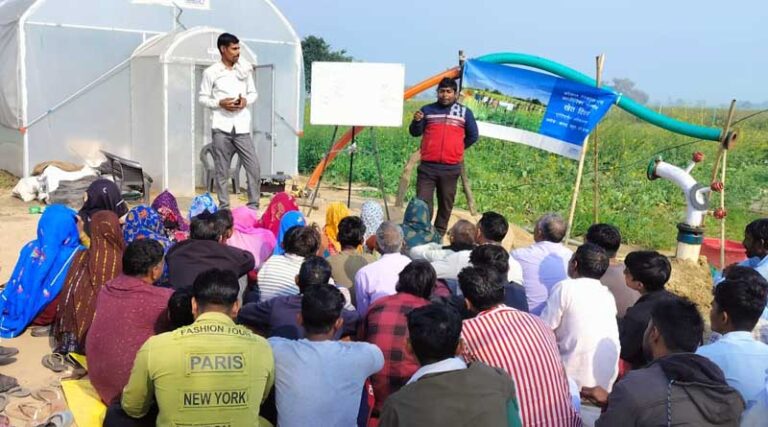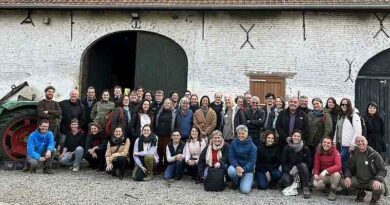
Exemplifying Holistic Village Development
Guest Author: Deepak Kumar and Akhilesh Sharma
29 July 2025, New Delhi: What is development? There are many answers to this question. In the words of Edgar Owens, a world-renowned author, “Development is when people develop, not things.” This perspective emphasizes that true progress lies in empowering people rather than merely building infrastructure. Development should enhance people’s capabilities, enabling them to sustain and improve their lives while fostering resilience within communities.
S M Sehgal Foundation embraces this people-centered approach by designing and implementing development initiatives that are sustainable in the long run. A project is considered sustainable when it strengthens a community’s ability to cope with challenges, enhances its resources and skills, and continues to yield benefits without depleting natural resources. Sustainability in rural development is not just about maintaining physical assets like check dams, ponds, agricultural machinery, schools, or irrigation systems. It also involves building human and social capital by providing communities with access to information, awareness, skills, problem-solving abilities, and collaboration opportunities. This asset-capability approach ensures that development is not only socially and economically viable but also environmentally responsible.
A fundamental step in fostering sustainable development is the formation of community-based institutions, such as Village Development Committees (VDCs), women’s groups, or water management committees. These institutions serve as platforms for communities to articulate their needs, participate in planning, and lead initiatives in collaboration with local governance structures like gram panchayats. To guide grassroots practitioners in fostering sustainability, the VCCS model—Village Development Committee, Capacity Development, Convergence, and Sustainability—offers a structured pathway. This model has helped communities take ownership of initiatives by working in synergy with local institutions, ensuring that the benefits endure for generations. However, in areas where social capital is weak, the process requires more time and effort.
This approach was successfully implemented in the HDFC Parivartan Project in Chhata, Mathura, where VDCs were established across 15 villages. These committees, inclusive of all societal groups, played a pivotal role in driving participatory development and ensuring the long-term sustainability of the project’s interventions.
Khursi village, located in Chhata Block of Mathura District, Uttar Pradesh, was like many rural villages in India—a patriarchal society primarily dependent on traditional agricultural practices. The village faced multiple socio-economic challenges.
When the Sehgal Foundation began its intervention in Khursi, the community was sceptical, having experienced setbacks in development work in the past. To bridge this trust deficit, the team organized inclusive community meetings, ensuring representation from different wards and various castes. This effort laid the foundation for a VDC, a platform to facilitate community-led development. The committee consisted of twenty-six members, including ten women—a significant shift in a village where women’s presence in public forums like the Chaupal was almost non-existent. Through continuous training and capacity-building sessions, the VDC began to assert its role in village development, marking a turning point for Khursi, particularly in the empowerment of women. The village had a population of approximately 950 households, with a majority engaged in agrarian livelihoods. While only a few households could be classified as Above Poverty Level (APL), most households in the village faced economic hardships.
One of the VDC’s first initiatives was to install solar street lights across the village. Before this intervention, the village plunged into darkness after sunset, making mobility difficult and raising security concerns, especially for women and children. The installation of solar lights not only brightened the village pathways but also instilled a newfound sense of safety and confidence among the villagers. While site selection for the lights initially posed challenges, the active engagement and consensus-building efforts of the VDC members helped resolve the issue efficiently.
Agriculture, the backbone of the village economy, had remained unchanged for generations, relying on traditional techniques and manual labour. Before the intervention, only twelve farmers possessed essential farming tools such as harrows, cultivators, seed drills, and cotton sowing machines. To modernize farming practices and improve productivity, an Agri-Tool Operators Group (ATOG) was formed in June 2024, with seven members. The introduction of modern equipment like zero-till drills, tractor-mounted sprayers, and power weeders on a rental basis at subsidized rates significantly reduced labour dependency and costs. Previously, spraying pesticides on an acre of farmland required nearly four hours of labour for Rs 500. With the tractor-mounted sprayer, the same task was completed in just an hour at Rs 2500. Similarly, power weeders slashed costs from Rs 2400 per acre to Rs 1200 per acre, cutting working hours by more than half. As a result, twenty-eight farmers benefited from these modern techniques, covering fifty-nine acres and generating substantial savings while improving efficiency. The earnings from ATOG rentals amounted to Rs 27,675, with a small portion reserved for equipment maintenance.
Beyond mechanization, the intervention also encouraged farmers to diversify their crops. Traditionally, cotton, mustard, and wheat dominated the fields, while vegetable farming was rare due to saline water conditions and a lack of awareness. Farmer Field Schools and training sessions introduced innovative practices that made vegetable cultivation viable. One progressive farmer, Neeraj, decided to experiment with tomatoes and peas, transforming his income potential. While he previously earned Rs 40,000 per acre from cotton cultivation, his earnings surged to Rs 1,00,000 per acre by switching to vegetables. Encouraged by his success, several farmers followed suit, leading to an expansion of vegetable farming to eight acres, marking a significant departure from conventional crop patterns.
Education was another critical area that saw a remarkable transformation. The village school, once plagued by inadequate infrastructure, underwent significant improvements facilitated by the VDC. The introduction of smart classrooms, a drinking water station, sanitation units, a science lab, and a library enhanced the learning environment. Additionally, the Building as Learning Aid (BaLA) paintings were introduced to make classroom walls interactive and engaging. These efforts contributed to improved learning outcomes, reduced dropout rates, and increased enthusiasm for education among children. As a result, seventy students, including thirty-nine girls, benefited from these educational advancements, paving the way for a brighter future.The livelihood opportunities for women also expanded through targeted interventions. The VDC initiated a livestock distribution program, empowering marginalized families to achieve economic stability. Surekha, one of the beneficiaries, received four does and a buck, which multiplied over time, significantly increasing her earnings. From having limited income opportunities, she was able to generate eighty-five thousand rupees through livestock sales. To support this initiative, village women were trained as Gram Sakhis, equipping them with veterinary knowledge to ensure better livestock health and productivity. These efforts not only improved household incomes but also reinforced women’s participation in economic activities.
The VDC’s role extended beyond agriculture and livelihoods, successfully bridging the gap between villagers and government welfare schemes. Ms. Anju Singh, a VDC member, played a crucial role in facilitating applications for various government programs, ensuring that over twelve hundred farmers received PM-KISAN benefits. Additionally, she assisted in securing LPG connections under the Ujjwala Yojana and helped elderly villagers enrol in pension schemes, further improving the community’s overall well-being. The increasing involvement of women in governance and decision-making marked a profound shift in the village’s socio-political fabric.
The transformation of Khursi village embodies the essence of self-reliant and sustainable rural development. Through collective action, the community has reduced its dependency on external resources, improved its agricultural practices, strengthened local governance, and enhanced socio-economic conditions. This journey of empowerment and progress aligns closely with Mahatma Gandhi’s vision of Village Swaraj—a self-sufficient and resilient rural society. From better agricultural productivity to improved education and greater gender inclusivity, Khursi now stands as a model of community-driven transformation, showcasing the power of participatory development and local leadership.
(About the Authors: Deepak Kumar, Assistant Manager, Partnerships & Fundraising and Akhilesh Sharma, Program Lead, Agriculture Development, S M Sehgal Foundation)
📢 If You’re in Agriculture, Make Sure the Right People Hear Your Story.
From product launches to strategic announcements, Global Agriculture offers unmatched visibility across international agri-business markets. Connect with us at pr@global-agriculture.com to explore editorial and advertising opportunities that reach the right audience, worldwide.






